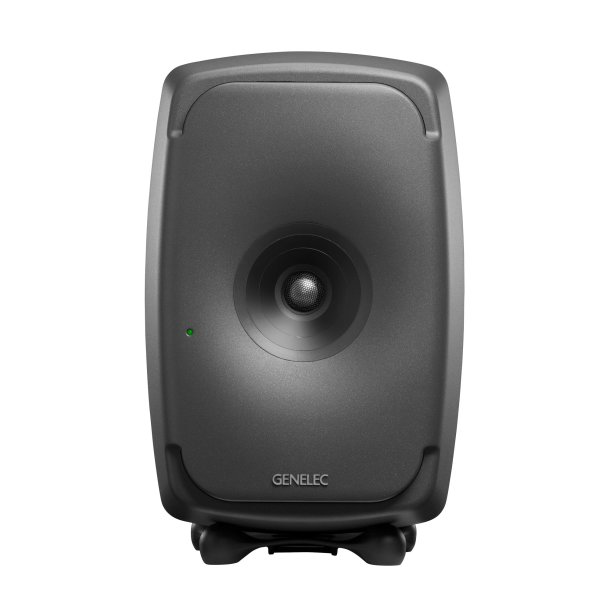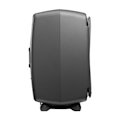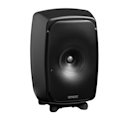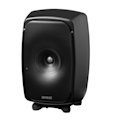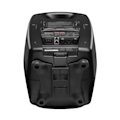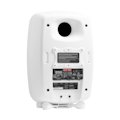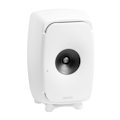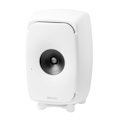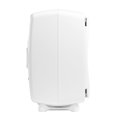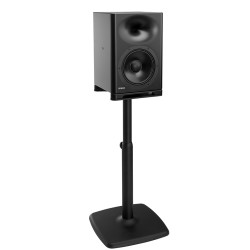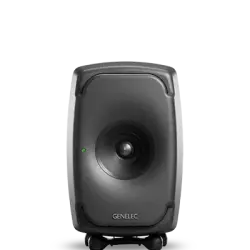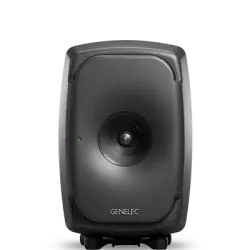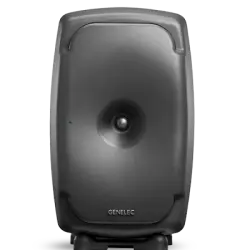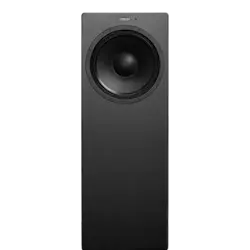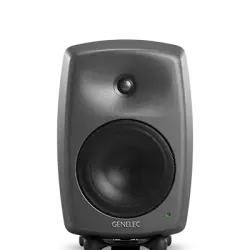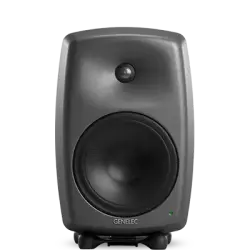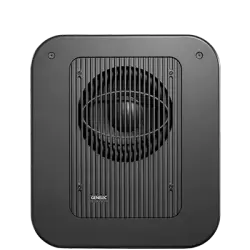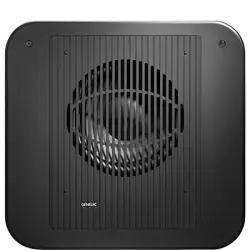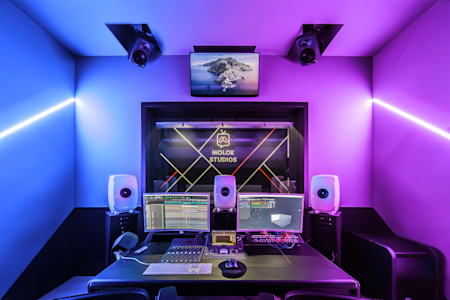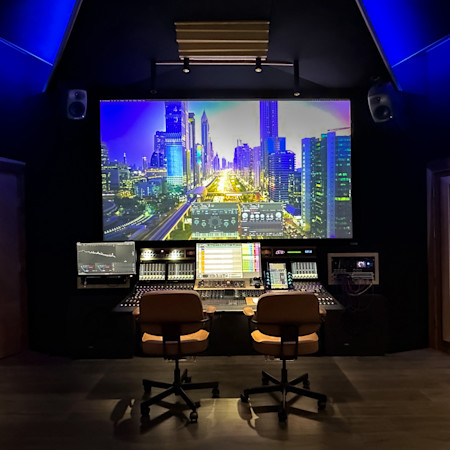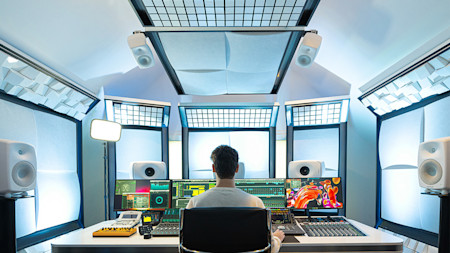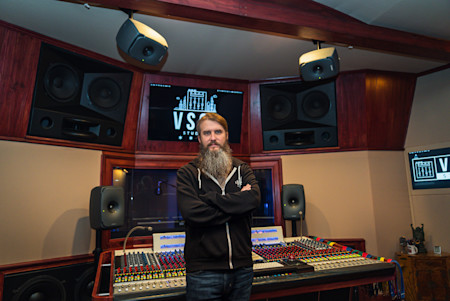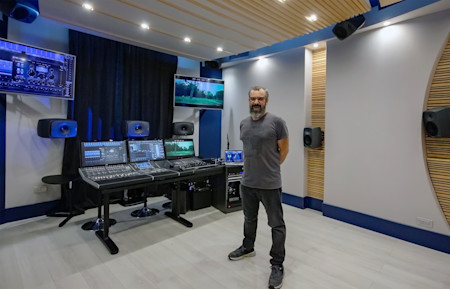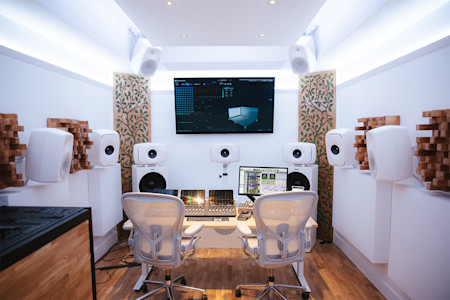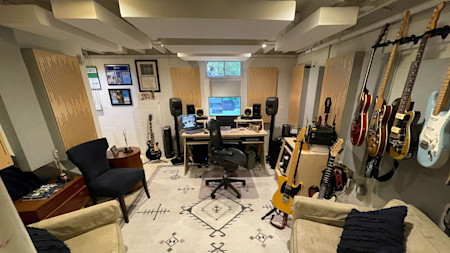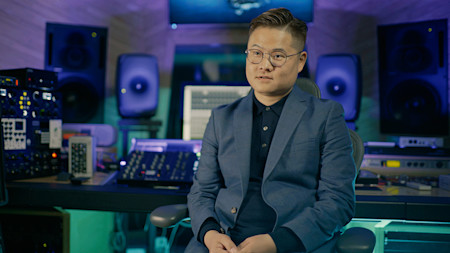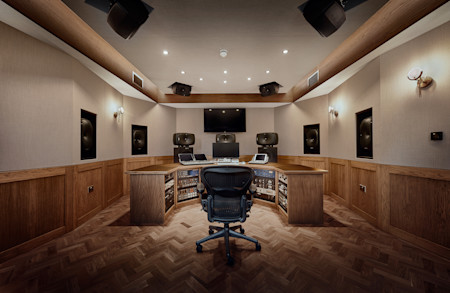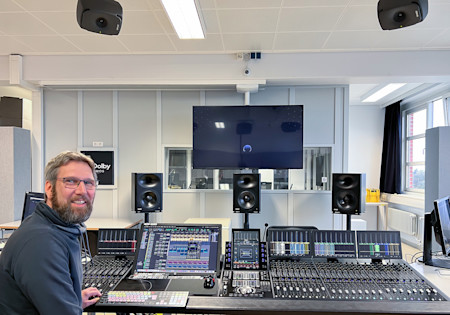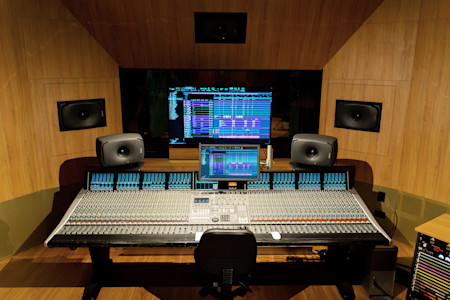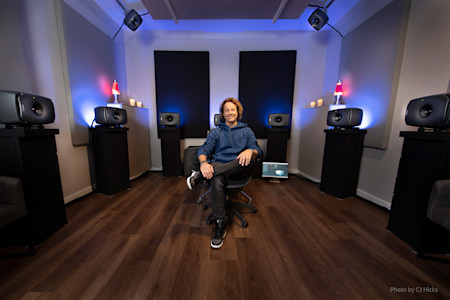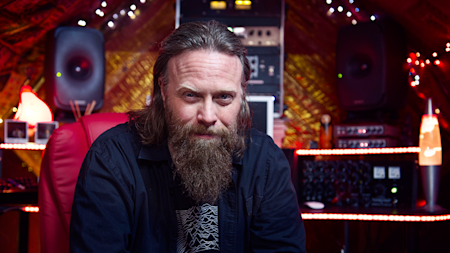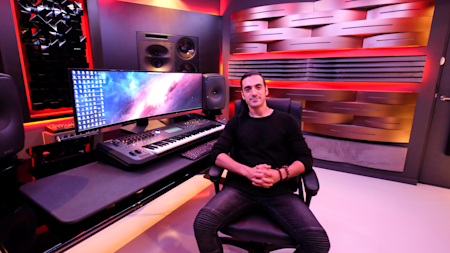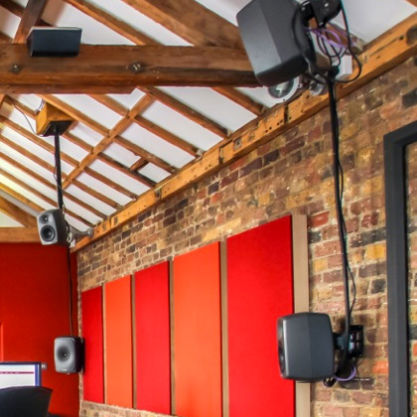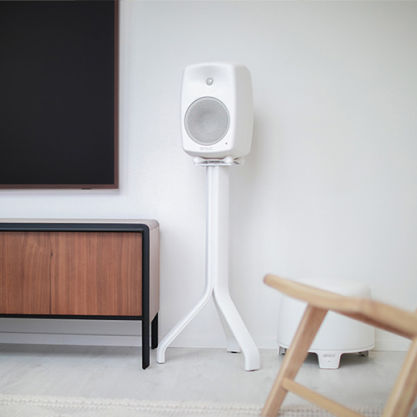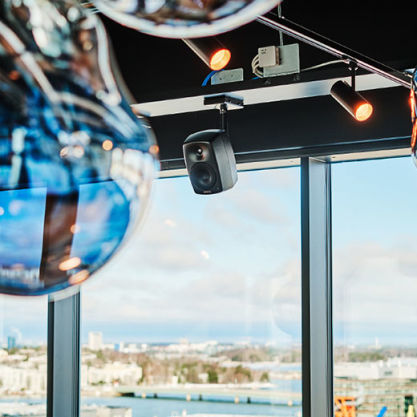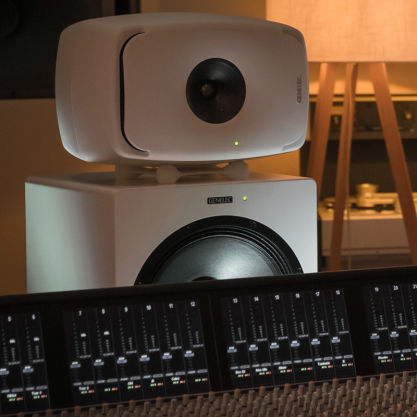A revolution in three-way monitor design, the 8351B boasts a unique look, compact size and a performance that has to be heard to be believed.
8351B
SAM™ Studio Monitor

Smart Active Monitoring (SAM™) and GLM™ calibration technology

Minimum Diffraction Coaxial (MDC™) Driver Technology

SPL
113 dB

Frequency Response
32 Hz - 43 kHz (-6 dB)

Dimensions
H 454 x W 287 x D 278 mm, with Iso-Pod™ (view in inches)
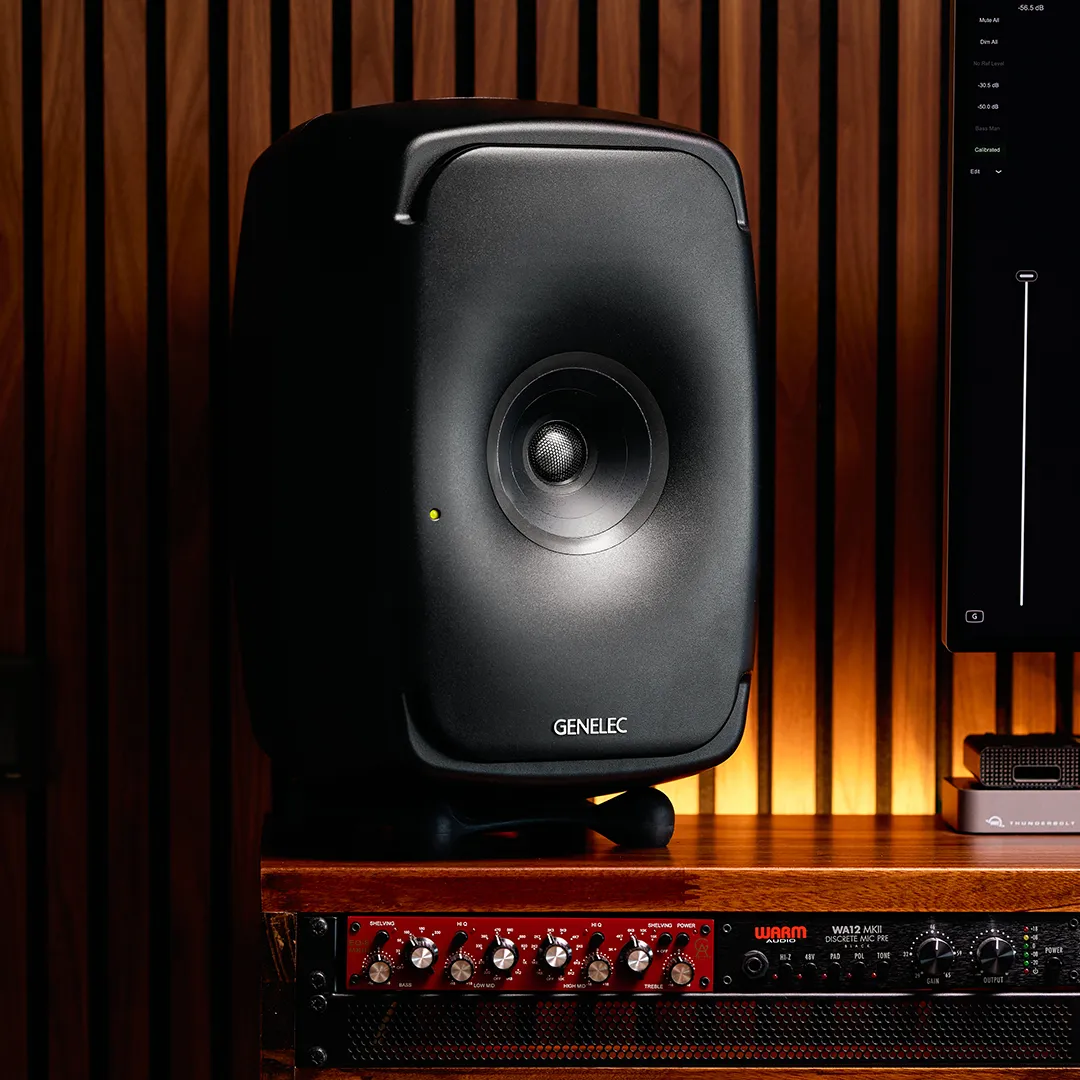
Uncoloured precision
The upgraded 8351B now offers increased SPL, additional room compensation EQs, equalised delay and enhanced HF response. Offering the same extraordinary imaging and uncoloured precision of its smaller 8331A and 8341A siblings, the 8351B provides even greater LF extension, while its higher maximum SPL enables longer listening distances.
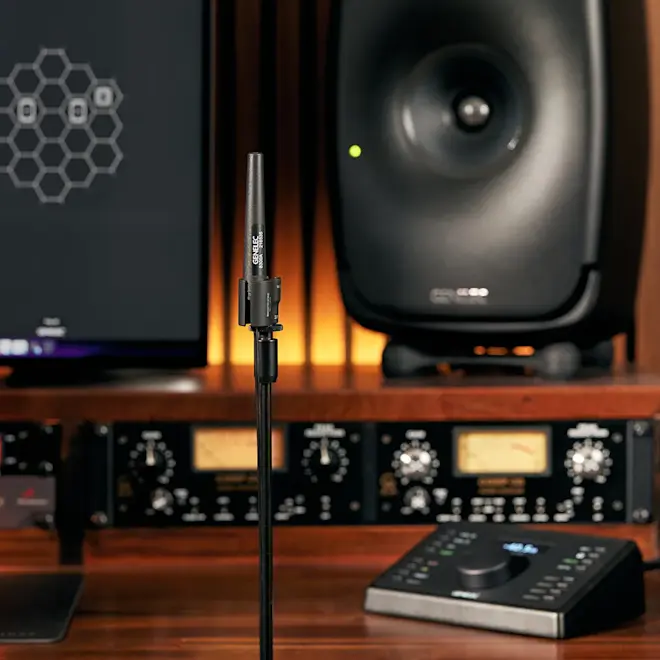
Work faster, for longer
The 8351B promotes faster and more consistent decision making, but also allows you to work reliably on longer sessions - because unnatural imaging, a main contributor to listener fatigue, is minimised. And in conjunction with our GLM software, it will adapt to your space and compensate for detrimental room influences. From mono to immersive, you can be confident of producing mixes that will translate beautifully to other rooms and systems.
8351B
Awards

It’s our great pleasure to report that globally respected magazine Sound On Sound have awarded our 8351B Smart Active Monitor the ‘Highly Commended’ accolade in the Studio Monitor category of this year’s SOS Awards. The honour is the direct result of votes cast by the magazine’s knowledgeable readership of engineers, producers and creatives.
We’d like to extend our sincere gratitude to everyone that voted for us, and to thank every user that’s given us valuable feedback about the 8351B – it means a great deal to us.

Genelec's The Ones monitors were awarded a "Producto del Año 2017" award by Hispasonic.

Genelec SAM™ Coaxial Studio Monitors 8331, 8341 and 8351, also known as "The Ones", were awarded with the MusicTech Gear of the Year 2017 award in "The Best Monitors" -category.

Genelec SAM™ Coaxial Studio Monitors 8331, 8341 and 8351, also known as "The Ones", were awarded with the MusicTech Gear of the Year 2017 award in "Product of the Year" -category.
Genelecs The Ones monitors were awardede a Beijing International Music & Hi-Fi Show award 2017 in the category of "Most Influential Product".
Genelec's The Ones monitors were awarded a IFTT C&C Award 2017 (International Film and Television Technology Creative & Craft Award).
Genelec's The Ones monitor series was awarded a Super AV Award 2017 in the category of Outstanding Overall Performance.
Genelec SAM™ Coaxial Studio Monitors 8331, 8341 and 8351, also known as "The Ones", were awarded a SOS Global Readers Award 2018 in "Highly Commended" -category.
Genelec's The Ones series monitors were awarded a Resolution Award 2018 in the "Monitoring" category.
Technical Specifications

SPL
113 dB

Amplifier Power
250 W Bass (Class D) + 150 W Midrange (Class D) + 150 W Treble (Class D)

Frequency Response
32 Hz - 43 kHz ("-6 dB")

Accuracy of Frequency Response
± 1.5 dB (38 Hz - 20 kHz)

Driver Dimensions
2 x H 101 x W 218 mm Bass + ⌀ 130 mm Midrange + ⌀ 25 mm Treble (view in inches)

Dimensions
H 454 x W 287 x D 278 mm, with Iso-Pod™ (view in inches)

Weight
14.3 kg / 31.5 lb

Connections
1 x XLR Analog Input
1 x XLR AES/EBU Input
1 x XLR AES/EBU Output
2 x RJ45 Control
8351B SAM™ Studio Monitor
SAM™ Studio Monitor
Technical Specifications
A revolution in three-way monitor design, the 8351B boasts a unique look, compact size and a performance that has to be heard to be believed.
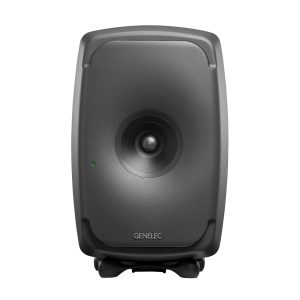
System Specifications
Frequency Response
38 Hz - 20 kHz (± 1.5 dB)
Low cutoff -6dB
32 Hz
High cutoff -6dB
43 kHz
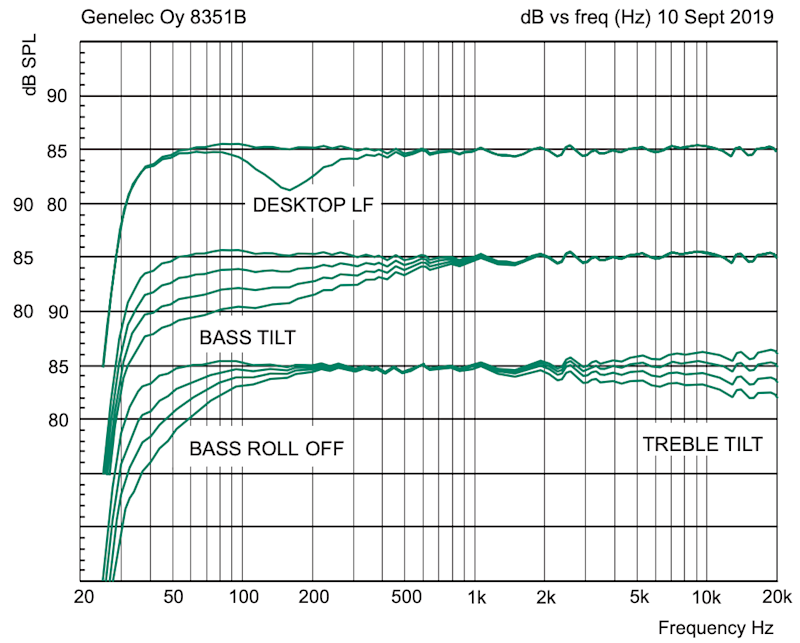
SPL
Peak SPL Maximum peak SPL output per pair on top of console at 1 m with music material.
≥118 dB
Short term max SPL Maximum short term sine wave SPL output at 1 m on axis in half space, averaged as specified (from 100 Hz to 3 kHz).
≥113 dB
Long term max SPL Maximum long term RMS acoustic output in the same conditions with IEC weighted noise (limited by driver protection circuit) at 1 m.
≥103 dB
Self-generated noise
Self-generated noise Self generated noise level in free field at 1 m on axis (A-weighted)
≤5 dB SPL
Weight
Weight14.3 kg (31.5 lb)
Dimensions
Height
433 mm
Height with Iso-Pod
454 mm
Width
287 mm
Depth
278 mm
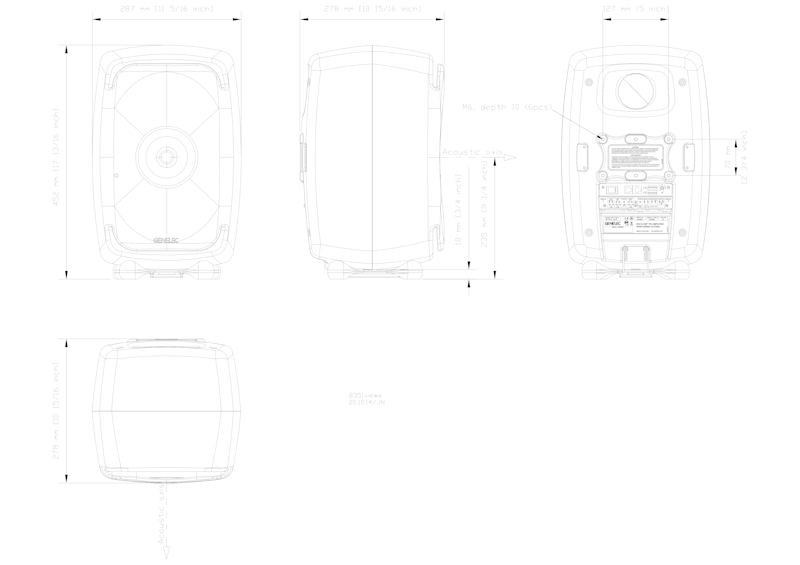
Enclosure
Enclosure material
Die cast aluminium
Enclosure type
Reflex port
Drivers
Driver type
Racetrack
Dual 218 x 101 mm (85/8 x 4 in) obround cones
Count
2
Width
218 mm
Height
101 mm
Driver type
Coaxial
8351B midrange driver cone (coaxial)
Diameter
130 mm
Driver type
Coaxial
8351B treble driver metal dome (coaxial)
Diameter
25 mm
Directivity
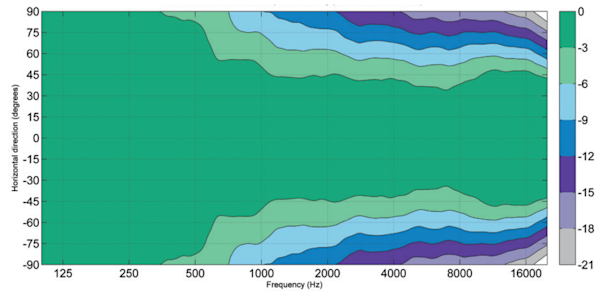
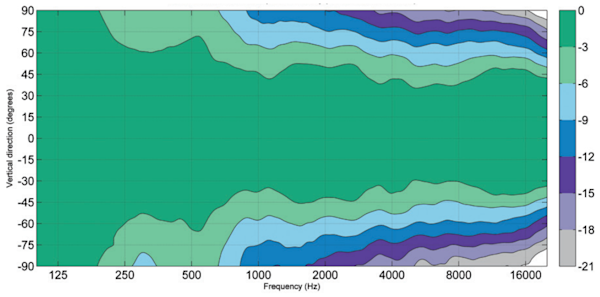
Harmonic distortion
> 100 Hz ≤0.5 %
Group delay
The latency at high frequencies from the input to the acoustic output, measured in the analog input:
Extended Phase Linearity in GLM set to OFF (top graph)
3.1 ms
Extended Phase Linearity in GLM set to ON (bottom graph)
7.5 ms
In Genelec performance graphics, the time of converting the from an electronic input signal to the acoustic output in a Genelec monitor is described by two factors – latency and group delay. The group delay factor can be read in the graphics for a specific frequency. The total frequency-specific input-to-output delay is a sum of the latency and group delay factors. To understand the significance of this total delay, consider that moving a loudspeaker away by 1 meter creates an additional delay of about 3 ms.


Amplifier Section
Amplifiers
250 W Class D
150 W Class D
150 W Class D
Mains voltage
100-240 VAC 50/60Hz
Power consumption
ISS Active
≤1 W
Idle
≤16 W
Full output
200 W
Signal processing section
Connectors
Input Analog signal input connector XLR female (10 kOhm input load impedance).
Input XLR female (conforms to IEC 60958-4)
Output XLR male (conforms to IEC 60958-4)
2 x Control Two CAT5 (RJ45) GLM Network connectors for computer control using the Genelec Loudspeaker Manager (GLM) software.
Crossover
Bass/Mid
320 Hz
Mid/Treble
2800 Hz
Product Variants
Product codes
Compatible Accessories
Product codes
For even more technical details please see product operating manual.
Key Technologies

Smart Active Monitoring (SAM™) and GLM™ calibration technology

Minimum Diffraction Coaxial (MDC™) Driver Technology

Acoustically Concealed Woofers (ACW™) Technology

Active Crossovers

Directivity Control Waveguide (DCW™) Technology

Intelligent Signal Sensing (ISS™) Technology

Iso-Pod™ Stand

Minimum Diffraction Enclosure (MDE™) Technology

Optimised Amplifiers

Protection Circuitry

Reflex Port Design

Versatile Mountings
Networked Smart Active Monitor (SAM™) Systems feature automatic calibration to the environment.

Now, more than ever, audio productions are engineered in tighter, more confined working environments. This increases acoustic problems and lowers the reliability of monitoring. At the same time, an audio engineer's need to trust a reliable and precise monitoring system that reproduces sound neutrally and without distortion has not changed.
Built upon the solid electro-acoustic foundations of our 1200, 8000 and 7000 Series products, Genelec SAM Systems are today’s most advanced and flexible monitoring solutions. They are an indispensable tool for audio professionals, as they automatically adapt to the acoustic environment and correct for level, delay and room anomalies. SAM Systems are controlled using Genelec's proprietary Loudspeaker Manager (GLM™) network and software, enabling you to build a highly flexible and reliable monitoring system.
GLM is a highly intuitive and powerful monitor control networking system that manages connectivity to all SAM studio monitors and subwoofers on the network. GLM software features adjustment of level, distance delay and flexible room response compensation equalisation with our state-of-the-art, highly robust AutoCal™ 2 algorithm automated calibration system. All parameters and settings are stored in system setup files or saved in each individual monitor or subwoofer, if the GLM network needs to be disconnected.
Also, all acoustical features of SAM Systems can be optimised and tailored for different working styles or client demands. Additionally, even if the monitors or the production projects move between rooms, you can expect SAM technology to provide the highest consistency in monitoring, providing neutral soundstage imaging with low distortion – in each environment.
Genelec SAM Systems offer a comprehensive, solution-oriented, intelligently networked product range supporting analogue and digital signals in virtually any working environment.
Minimum Diffraction Coaxial (MDC™) Driver Technology reproduces outstanding sound image.

Typical coaxial designs suffer from a somewhat ragged frequency response due to diffraction problems inherent in their unrefined design. However, crossover issues due to the non-coincident location of sources are solved with a coaxial configuration, so a coaxial solution without diffraction problems is the ideal. Genelec’s Minimum Diffraction Coaxial (MDC™) Driver Technology provides all the benefits of coaxial design while overcoming the typical shortages – solving the diffraction problem.
The first step is to minimise the cone displacement, in other words to limit the low frequency bandwidth of the driver. Next, is to avoid all sources of diffractions. The main structure of the MDC design consists of an integrated MF diaphragm-suspension tweeter construction. The visible part of the coaxial driver is formed by the curved flexible skin with the dome tweeter assembly in its centre. The inner section joins the cone to the tweeter without any acoustical discontinuity, and the outer one does the same between the cone and the driver chassis.

As there are no acoustically observable discontinuities between the tweeter and the cone, just a smooth surface, there is no diffraction either. The cone profile is very carefully optimised to form an integrated directivity control waveguide for the tweeter radiation. The driver outer edge is terminated to a normal Genelec DCW in order to control the dispersion of midrange radiation as well. The response is very smooth both on and off-axis and free from any anomalies – and directivity is well controlled.
This breakthrough in coaxial design provides improved imaging and overall sound quality on and off-axis, extremely smooth frequency response leading to outstanding clarity and definition of the inner details of the music.

The main novelties of Genelec combined DCW™ and MDC™ designs:
- Diffraction-free joint between tweeter and midrange diaphragm.
- Diffraction-free joint between midrange diaphragm and DCW™ waveguide.
- A proprietary midrange diaphragm technology – laminate structure combining a rigid cone and elastic, lossy materials including the suspension itself.
- A midrange diaphragm-suspension pair which cancels all possible non-linearity.
Advantages:
- Smoother frequency response.
- Ensures the drivers couple coherently over their full operating bandwidth.
- Significantly improves the directivity control in the critical frequency range.
- Provides balanced suspension dynamics to minimise acoustic distortion.
- Optimises the use of the front baffle area while maintaining the 8000 Series appearance and benefits.
Acoustically Concealed Woofers (ACW™) for controlled directivity down to low frequencies.

The 8351 Acoustically Coaxial Three-way system features our novel Acoustically Concealed Woofer (ACW™) technology. The Acoustically Concealed Woofers radiate through slots located on both ends of the enclosure.
The 8351 features two woofers and the positions of the two woofers have been chosen to extend the coaxial acoustical radiation concept towards low frequencies. In terms of low frequency directivity, when two woofers are used, separated by a distance, the system of two woofers behaves acoustically like one giant woofer spanning the distance between the two woofers. Also, such a dual woofer design extends the control of the directivity to low frequencies along the largest front baffle dimension.
The ACW technology makes the woofer openings and the woofer drivers acoustically invisible to the acoustical radiation from the minimum diffraction coaxial (MDC™) driver responsible for the midrange and tweeter frequencies. The radiation openings are optimized for size and curvature to minimize any acoustic diffractions.
The ACW solution also allows us to use the whole front baffle surface of the 8351 as one giant Directivity Control Waveguide (DCW™) that is part and built into a Minimum Diffraction Enclosure (MDE™).
The 8351 ACW arrangement creates a monitor that has a physically compact size yet behaves like a much larger system in terms of low frequency directivity.
Such controlled low frequency directivity translates to improved quality of monitoring and smaller low frequencies interaction between the monitor and the room.
Active crossover operating at low signal levels.

Audio electronic crossovers allow the audio signal to be split into separate frequency bands that are separately routed to individual power amplifiers, which are then connected to specific transducers optimised for a particular frequency band.
Active crossovers come in both digital and analogue varieties. Genelec digital active crossovers include additional signal processing, such as driver protection, delay, and equalisation.
Genelec analogue active crossover filters contain electronic components that are operated at low signal levels suitable for power amplifier inputs. This is in contrast to passive crossovers that operate at the high signal levels of the power amplifier's outputs, having to handle high currents and, in some cases, high voltages.
In a typical two-way system the active crossover needs two power amplifiers — one for the woofer and one for the tweeter.
The active crossover design offers multiple benefits:
- The frequency response becomes independent of any dynamic changes in the driver's electrical characteristics or the drive level.
- There is increased flexibility and precision for adjusting and fine-tuning each output frequency response for the specific drivers used.
- Each driver has its own signal processing and power amplifier. This isolates each driver from the drive signals handled by the other drivers, reducing inter-modulation distortion and overdriving problems.
- The ability to compensate for sensitivity variations between drivers.
- The possibility to compensate for frequency and phase response anomalies associated with a driver’s characteristics within the intended pass-band.
- The flat frequency response of a high-quality active loudspeaker is a result of the combined effect of the crossover filter response, power amplifier responses and driver responses in a loudspeaker enclosure.
Using the active approach enables frequency response adjustments and optimisation of the full loudspeaker system, placed in various room environments, without expensive external equalisers. The end result is a simpler, more reliable, efficient, consistent and precise active loudspeaker system.
Directivity Control Waveguide (DCW™) for flat on and off-axis response.

A revolutionary approach was taken by Genelec in 1983 with the development of its Directivity Control Waveguide (DCW™). We have developed and refined this technology over more than 30 years to greatly improve the performance of direct radiating multi-way monitors.
The DCW technology shapes the emitted wavefront in a controlled way, allowing predictable tailoring of the directivity (dispersion) pattern. To make the directivity uniform and smooth, the goal is to limit the radiation angle so that the stray radiation is reduced. It results in excellent flatness of the overall frequency response as well as uniform power response. This minimises early reflections and provides a wide and controlled listening area achieving accurate sound reproduction on and off-axis.
Minimised early reflections and controlled, constant directivity have another important advantage: the frequency balance of the room reverberation field is essentially the same as the direct field from the monitors. As a consequence, the monitoring system's performance is less dependent on room acoustic characteristics.
Sound image width and depth, critical components in any listening environment, are important not only for on-axis listening, but also off-axis. This accommodates not only the engineer doing their job, but also others in the listening field, as is so often the case in large control rooms.
DCW™ Technology key benefits:
- Flat on and off-axis response for wider usable listening area.
- Increased direct-to-reflected sound ratio for reduced control room coloration.
- Improved stereo and sound stage imaging.
- Increased drive unit sensitivity up to 6 dB.
- Increased system maximum sound pressure level capacity.
- Decreased drive unit distortion.
- Reduced cabinet edge diffraction.
- Reduced complete system distortion.
Intelligent Signal Sensing (ISS™) for power consumption reduction in stand-by mode.

Introduced early 2013, Genelec’s Intelligent Signal-Sensing technology has been developed to meet with both European Union ErP Directives and Genelec's own ambitious sustainability standards.
The Intelligent Signal Sensing, ISS™ circuitry tracks the signal input of the loudspeaker and detects if it is in use. If the ISS circuit does not find any audio on the input for a period of time, it sets the loudspeaker to a low-power sleep state and the loudspeaker will consume less than 0.5 watts. When an input signal is detected, the loudspeaker immediately turns itself on.
Additionally an ‘ISS Disable’ switch is located on each product’s back plate next to the other room response controls. First, when the mains power switch of the loudspeaker is set to 'ON', the ISS™ auto-start function (low-power sleep state on/off) of the loudspeaker is active.
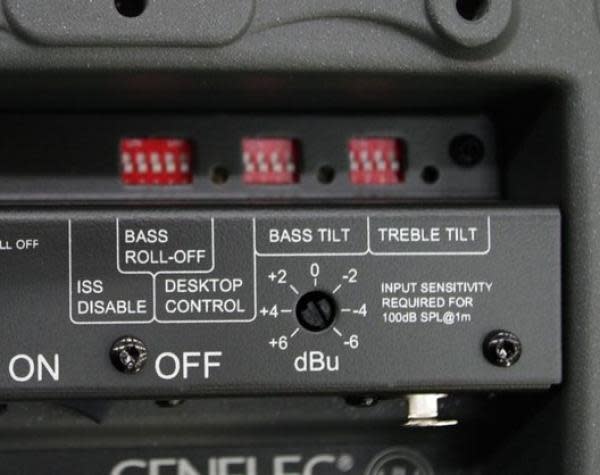
If this function is not desired, the ISS™ function can be disabled by setting the 'ISS Disable' switch on the back panel to 'ON' position. In this mode, the monitor is only powered on and off using the mains power switch.
Note that the mains power switch will always turn the monitor off completely.
Vibration decoupling Iso-Pod™ stand improves sound image definition.

Although it is advisable to use sturdy and stable floor stands together with free-standing loudspeakers, a very common solution is to place loudspeakers directly on a table or on a console meter bridge.
This causes several detrimental side effects. Aiming of the loudspeaker axis towards the listener is rarely implemented, also, unwanted mechanical vibration do propagate from the loudspeaker to the mounting surface, and first order reflection on the work surface causes comb filtering and hence ripples in the frequency response.
To solve these very common problems Genelec developed an efficient and very practical solution. We designed a loudspeaker stand called Iso-Pod™ - Isolation Positioner/Decoupler that is attached to the aluminium enclosure. It has four shallow feet and it is made from special lossy rubber-like material. It is firmly attached to the enclosure so that it can be slid along the curved bottom or side surface to allow for a ±15° tilt of the loudspeaker.
The loudspeakers’ acoustical axis can then be pointed precisely towards the listener by adjusting the enclosure’s inclination with the Iso-Pod. The vibration isolation and damping properties reduce midrange coloration caused by unwanted vibration transmitted to supporting surfaces.
This innovative solution is an integral part of Genelec loudspeaker design and provides clear benefits in usability and sound quality.
Minimum Diffraction Enclosure (MDE™) for uncoloured sound reproduction.

A common problem with standard free-standing loudspeakers is that the front baffle discontinuities cause diffractions and the loudspeaker sharp corners act as secondary sources through reflections.
In order to improve the flatness of the frequency response and the power response of free standing loudspeaker systems, Genelec have designed a highly innovative enclosure optimized to match the properties of the monitor drivers, featuring rounded edges, and gently curved front and sides. In addition to achieving an unsurpassed flatness of the frequency response, the enclosure having minimum diffractions yields superb sound stage imaging qualities.
To achieve such a smooth and elegantly curved cabinet surface and to reduce the outer dimensions of the enclosure, maximising at the same time the internal volume for improved low frequency efficiency, we designed a cabinet made off die-cast aluminium. Aluminium is lightweight, stiff and very easy to damp to yield a “dead” structure. The cabinet walls can be made fairly thin, providing at the same time good EMC shielding and excellent heat sink for the power amplifiers. Die-casting is made in two parts, front and rear, and they are easy to separate for potential servicing needs.
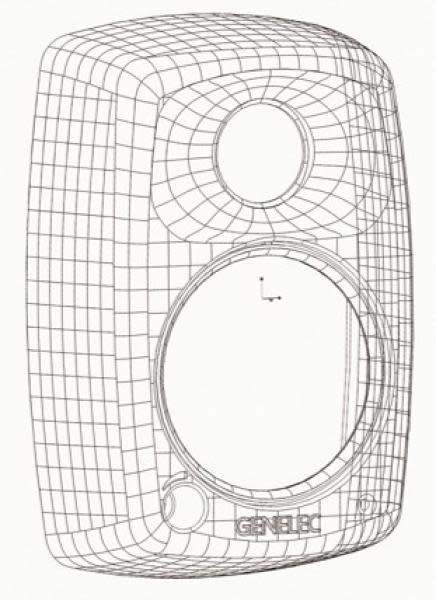
The DCW waveguide has been integrated in the MDE aluminium enclosure to provide improved control of the loudspeaker’s directivity. Basically, the low frequency limit for constant directivity is determined by the size of the waveguide, so the larger the surface the better the control. With a very controlled off-axis radiation, the listening window becomes consistent, which is of utmost importance with multi-channel audio monitoring. Controlled directivity also reduces possible first order reflections on surfaces near the loudspeaker, helping to provide consistent audio reproduction in different acoustical environments. In fact, the entire front baffle is gently curved and the acoustically transparent grilles are part of the outer cabinet aesthetics, blending perfectly with the various other curved surfaces.

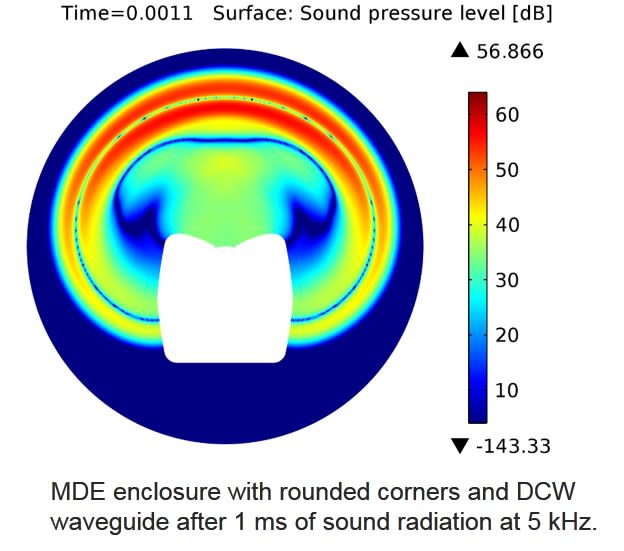
Each transducer is driven by its own optimised amplifier.
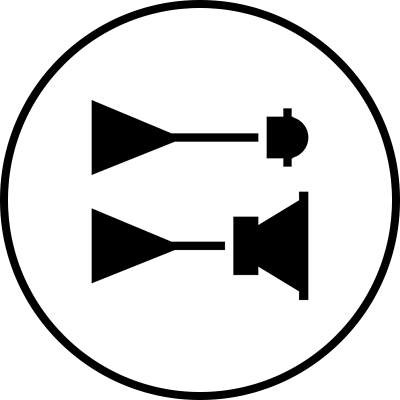
Audio electronic crossovers allow to split the audio signal into separate frequency bands that can be separately routed to individual power amplifiers, which are then connected to specific transducers optimised for a particular frequency band.
In a typical 2-way loudspeaker system, the active crossover needs two power amplifiers — one for the woofer and one for the tweeter. The power amplifiers are connected directly to the drivers of an active loudspeaker, resulting in the power amplifier’s load becoming much simpler and well known. Each driver-specific power amplifier has only a limited frequency range to amplify (the power amplifier is placed after the active crossover) and this adds to the ease of design.
The active design principle offers multiple benefits:
- The power amplifiers are directly connected to the speaker drivers, maximising the control exerted by the power amplifier’s damping on the driver’s voice coil, reducing the consequences of dynamic changes in the driver electrical characteristics. This may improve the transient response of the system.
- There is a reduction in the power amplifier output requirement. With no energy lost in the passive crossover filter components, the amplifier power output requirements are reduced considerably (by up to 1/2 in some cases) without any reduction in the acoustic power output of the loudspeaker system. This can reduce costs and increase audio quality and system reliability.
- No loss between amplifier and driver units results in maximum acoustic efficiency.
- Active technology can achieve superior sound output vs. size vs. low frequency cut-off performance.
- All loudspeakers are delivered as a factory aligned system (amplifiers, crossover electronics and enclosure-driver systems).
Sophisticated drive unit protection circuitry for safe operation.

When working in critical audio production environments it is essential that monitoring systems remain reliable and functional at all times. One of the main reasons behind Genelec’s excellent success in broadcasting environments is the reliability of our products and a key element behind the reliability is the internal protection circuitry found in all products since 1978.
The protection circuitry prevents driver failures by detecting signal levels, and in case of sudden peaks or constantly too high levels, taking the signal level down automatically. Of course this feature does not affect the sound quality in any way when working within the specifications of the loudspeaker, but only prevents inadequate input signals from breaking the loudspeaker.
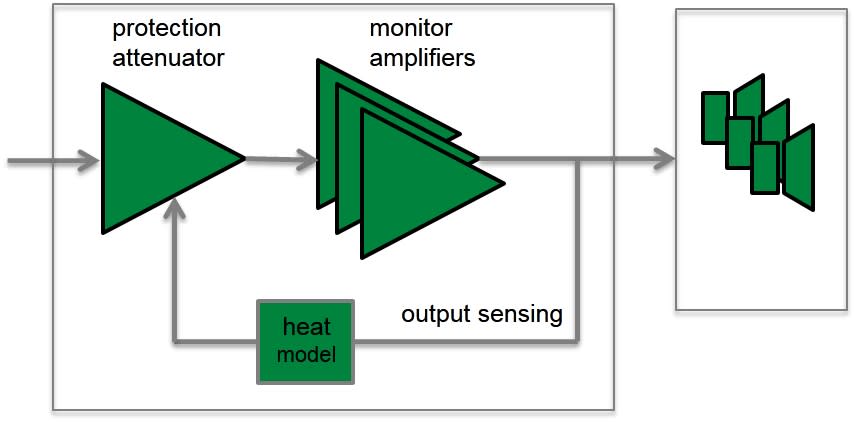
Protection circuitry features and benefits:
- Reduces the output level when required, (e.g. when driver voice coil temperature reaches the safe limit), which highly improves system reliability.
- Appropriate protection circuitry design in every loudspeaker and subwoofer enables the maximisation of system output sound level.
Advanced reflex port design for extended low frequency response.

Genelec’s choice for vented, or reflex, enclosures dates back to the S30 model, the first Genelec product from 1978. Port performance has been improved and refined over the years with the aim to increase the woofer’s low frequency extension and sound pressure level capability to provide outstanding bass articulation and definition.
Both driver and vent contribute to the total radiation of a reflex enclosure. Most radiation comes from the driver, but at the vent-enclosure resonant frequency the driver displacement amplitude is small and most of the radiation comes out of the vent.
To minimise the air speed in the tube, the cross sectional area of the vent should be large. This in turn means that the vent tube has to be long which presents quite a design challenge.
The long, curved tube maximises airflow so deep bass can be reproduced without compression. The reflex tube terminates with a wide flare located on the rear of the enclosure, minimising port noises and providing excellent bass articulation.
The curvature of the tube has also been carefully designed to minimise any audible noise, compression or distortion. The inner end of the tube has proper resistive termination to minimise once again audible chuffing noise and air turbulence.
Proper reflex port design allows also to significantly reduce the woofer’s displacement, improving the linear low frequency output capacity.
Versatile mounting options for all installation needs.

In addition to perfect acoustical design and advanced tailoring options to optimize the loudspeaker’s behaviour to the room environment, Genelec loudspeakers offer a variety of mounting options for easy installation in different applications.
Our wide range of accessories and fixed mounting points on the back of our aluminium enclosure products offer solutions to all common installation situations. M6 support points have been integrated in the die-cast enclosure for wall and ceiling mounts.
Some models also feature a 3/8” thread at the bottom of the enclosure to fit a robust microphone stand. Other larger and heavier models feature M10 fixing points. Special floor stand plates have been designed in order to fit the Iso-Pod stand that is part of our product design.
With these features our loudspeakers have found their way to a variety of applications beyond the professional audio and studio world, for example in commercial and AV installation projects as well as in home environments all around the world.
References
Genelec UNIO Explained | How the ecosystem offers seamless in-room and personal headphone monitoring
Genelec Visits Morten Lindberg’s Stunning Immersive Audio Studio
What is SAM technology? How will it benefit me?
What is GLM (Genelec Loudspeaker Manager)? | One Minute Masterclass Season 2 Part 9
Developing The Ones
Review: Genelec The Ones
We are The Ones
How GLM™ (Genelec Loudspeaker Manager) Software Works
Genelec UNIO Explained | How the ecosystem offers seamless in-room and personal headphone monitoring
A quick guide to our UNIO Ecosystem – which offers audio engineers seamless bridging of in-room and personal headphone monitoring. https://genelec.com/UNIO
The Genelec UNIO Ecosystem – which combines the power of our renowned GLM, SAM Monitoring and Aural ID adaptive technologies – gives audio engineers the flexibility to work anywhere, anytime, from stereo to immersive. And now, with the new UNIO Personal Reference Monitoring (PRM) solution, audio professionals benefit from the pinpoint accuracy of our pioneering active monitoring headphone solution, which combines the 9320A SAM Reference Controller with uniquely factory-calibrated 8550A Professional Reference Headphones.
To learn more, visit https://genelec.com/UNIO
Genelec Visits Morten Lindberg’s Stunning Immersive Audio Studio
In the world of immersive music recording, no-one has done more than Grammy-winning sound engineer and music producer Morten Lindberg to set the gold standard for what can be achieved in this field.
We visited Morten at his incredible studio in Oslo, Norway to talk about his approach to immersive recording, and how his new 7.1.4 Genelec monitoring system has become an essential part of his workflow.
Welcome to a fascinating insight into the world of a true immersive audio pioneer.
What is SAM technology? How will it benefit me?
What is Genelec’s Smart Active Monitor (SAM™) Technology and how will it benefit you?
What is GLM (Genelec Loudspeaker Manager)? | One Minute Masterclass Season 2 Part 9
GLM is a software for connecting, calibrating and controlling your Genelec SAM monitoring systems.
Developing The Ones
In this video we find out what the motivation was for creating Ultimate Point Source monitors, what benefits they offer, and what sets The Ones apart from every other studio loudspeaker that has gone before.
We are The Ones
Iisalmi, Finland. 19th October 2012. Our journey begins with inspiration from our users around the world. That inspiration found its way to Ilpo Martikainen’s notebook, and now we’re finally here. We wanted The Ones to point the way to the future of audio monitoring.
How GLM™ (Genelec Loudspeaker Manager) Software Works
Frustrated that your material doesn’t sound so great on other systems? In this video we show you how to calibrate the Genelec SAM™ monitors with the Genelec Loudspeaker Manager (GLM™) Software to get the most out of your room and ensuring that your mixes translate perfectly.
{"fi-FI":" ","ru-RU":" ","de-DE":" ","en-US":" ","sv-SE":" ","es-ES":" ","ja-JP":" "}
"Today we review the GENELEC 8351 studio monitors, the revolutionary 3-way Coaxial Speakers with Built-in DSP. We will discuss the importance of correct monitoring in professional studios and show how to calibrate the Speakers."
{"fi-FI":"RedStone Productions' [video review](https://youtu.be/YQgFl7H2g34 "RedStone Productions - LOOK INTO - Genelec 8351") of 8351 studio monitors.","ru-RU":"RedStone Productions' [video review](https://youtu.be/YQgFl7H2g34 "RedStone Productions - LOOK INTO - Genelec 8351") of 8351 studio monitors.","de-DE":"RedStone Productions' [video review](https://youtu.be/YQgFl7H2g34 "RedStone Productions - LOOK INTO - Genelec 8351") of 8351 studio monitors.","en-US":"RedStone Productions' [video review](https://youtu.be/YQgFl7H2g34 "RedStone Productions - LOOK INTO - Genelec 8351") of 8351 studio monitors.","sv-SE":"RedStone Productions' [video review](https://youtu.be/YQgFl7H2g34 "RedStone Productions - LOOK INTO - Genelec 8351") of 8351 studio monitors.","es-ES":"RedStone Productions' [video review](https://youtu.be/YQgFl7H2g34 "RedStone Productions - LOOK INTO - Genelec 8351") of 8351 studio monitors.","ja-JP":"RedStone Productions' [video review](https://youtu.be/YQgFl7H2g34 "RedStone Productions - LOOK INTO - Genelec 8351") of 8351 studio monitors."}
Stereo Sound Online Magazine's (JP) review of 8331 and 8341 SAM™ Studio Monitor. The review is written in Japanese and it was published in November 2017.
{"fi-FI":"Stereo Sound Online Magazine's (JP) review of 8331 and 8341 SAM™ Studio Monitor. The review is written in Japanese and it was published in November 2017.\n\nRead the full review: [Stereo Sound 8331 & 8341 Review](http://www.stereosound.co.jp/media/genelec/201712/ "Stereo Sound: 8331 and 8341 Review")","ru-RU":"Stereo Sound Online Magazine's (JP) review of 8331 and 8341 SAM™ Studio Monitor. The review is written in Japanese and it was published in November 2017.\n\nRead the full review: [Stereo Sound 8331 & 8341 Review](http://www.stereosound.co.jp/media/genelec/201712/ "Stereo Sound: 8331 and 8341 Review")","de-DE":"Stereo Sound Online Magazine's (JP) review of 8331 and 8341 SAM™ Studio Monitor. The review is written in Japanese and it was published in November 2017.\n\nRead the full review: [Stereo Sound 8331 & 8341 Review](http://www.stereosound.co.jp/media/genelec/201712/ "Stereo Sound: 8331 and 8341 Review")","en-US":"Stereo Sound Online Magazine's (JP) review of 8331 and 8341 SAM™ Studio Monitor. The review is written in Japanese and it was published in November 2017.\n\nRead the full review: [Stereo Sound 8331 & 8341 Review](http://www.stereosound.co.jp/media/genelec/201712/ "Stereo Sound: 8331 and 8341 Review")","sv-SE":"Stereo Sound Online Magazine's (JP) review of 8331 and 8341 SAM™ Studio Monitor. The review is written in Japanese and it was published in November 2017.\n\nRead the full review: [Stereo Sound 8331 & 8341 Review](http://www.stereosound.co.jp/media/genelec/201712/ "Stereo Sound: 8331 and 8341 Review")","es-ES":"Stereo Sound Online Magazine's (JP) review of 8331 and 8341 SAM™ Studio Monitor. The review is written in Japanese and it was published in November 2017.\n\nRead the full review: [Stereo Sound 8331 & 8341 Review](http://www.stereosound.co.jp/media/genelec/201712/ "Stereo Sound: 8331 and 8341 Review")","ja-JP":"Stereo Sound Online Magazine's (JP) review of 8331 and 8341 SAM™ Studio Monitor. The review is written in Japanese and it was published in November 2017.\n\nRead the full review: [Stereo Sound 8331 & 8341 Review](http://www.stereosound.co.jp/media/genelec/201712/ "Stereo Sound: 8331 and 8341 Review")"}
Documentation
Documents
8351B Operating Manual The Ones Brochure Immersive Solutions Brochure SAM™ Series Full Line Catalogue Genelec 8351B Operating Manual - Chinese Genelec Home Studio Audio Monitoring Guide (2023)Downloads
8351B - Simulation File (CLF) Line Drawing (PDF) 8351B Line Drawing (DWG) 8351B 8351B - Simulation File (GLL)Reviews
Recording Magazine - 8351B Review RedStone Productions, March 2018 (NL) Stereo Sound: 8331 & 8341 Review, November 2017 (Japan) Ljud & Bild (online): Genelec 8351 SAM - Monitorer på steroider, April 2016 (SE) Monitor Pro Magazine (PDF), March 2016 (DK) proaudio.de: Genelec 8351A - Near/Midfield Dreiwege-Studiomonitor mit Koaxialsystem, November 2015 (DE) Resolution Awards Winners' Supplement 2015, October 2015 Bonedo Magazin (online): Genelec 8351APM Test - Studiomonitor mit Koax-Chassis, June 2015 (DE) delamar Magazin (online): Genelec 8351 Testbericht, August 2015 (DE) Sound on Sound Magazine: Genelec 8351A Active Nearfield Monitor, August 2015 (UK) Canadian Musician Magazine, July 2015 (CA) Sound & Recording Magazin (PDF): Genelec 8351A Koaxialer 3-Wege-Monitor mit DSP-System, April 2015 (DE) i-fidelity online Magazin: Genelec 8351A - Auf den Punkt , April 2015 (DE) Stereoplay online Magazin: Graue Eminenz, March 2015 (DE)"Today we review the GENELEC 8351 studio monitors, the revolutionary 3-way Coaxial Speakers with Built-in DSP. We will discuss the importance of correct monitoring in professional studios and show how to calibrate the Speakers."
RedStone Productions' video review of 8351 studio monitors.
Stereo Sound Online Magazine's (JP) review of 8331 and 8341 SAM™ Studio Monitor. The review is written in Japanese and it was published in November 2017.
Stereo Sound Online Magazine's (JP) review of 8331 and 8341 SAM™ Studio Monitor. The review is written in Japanese and it was published in November 2017.
Read the full review: Stereo Sound 8331 & 8341 Review
Ljud & Bild's online review of 8351 studio monitors.
Ljud & Bild's online review of 8351 studio monitors in Swedish. The review was published in April 2016.
Monitor Pro Magazine's (DK) review of 8351A studio monitors. Published in March 2016.
Monitor Pro Magazine's (DK) review of 8351A studio monitors. Published in March 2016.
Proaudio.de website's online review of Genelec 8351A. The review is written in German and it was published in November 2015.
Proaudio.de website's online review of Genelec 8351A. The review is written in German by Peter Kaminski. It was published on proaudio.de website in November 2015.
The Genelec 8351 studio monitor was awarded a resolution award 2015. Find out the interesting product features of the winner by reading the article "Resolution Awards Winners' Supplement 2015", published in October 2015.
Resolution Awards Winners' Supplement 2015. The article was published in October 2015.
Bonedo Magazin's (DE) online review of 8351 studio monitor. The review was published in June 2015.
Bonedo Magazin's (DE) online review "Genelec 8351APM Test: Studiomonitor mit Koax-Chassis" of 8351 studio monitor. The review was published in August 2015, and is written by Felix Klostermann. It is available in German language.
Read the full review here.
"Die findigen Finnen bieten nun einen weiteren Lautsprecher mit automatischer Anpassung an die Raumakustik. Und der hat es in sich. Erfahre im Genelec 8351 Testbericht, wie die neuartige Konstruktion klanglich überzeugt und ob sich der Kauf auch für dich und dein Studio lohnt."
Quelle: www.delamar.de
delamar Magazine's (DE) online review "Genelec 8351 Testbericht: Studiomonitor mit automatischer Raumanpassung" was published in August 2015. The review is written in German language.
"Now, with the release of the 8351A Smart Active Monitor, Genelec have not only managed to develop a revolutionary approach to the art of three-way monitor design, but they've also managed to scratch all of my monitor itches at once."
-Bob Thomas, the author of the review article
Sound on Sound Magazine's (UK) review of Genelec 8351A Active Nearfield Monitor. Written by Bob Thomas. The review was published in August 2015.
"After taking the pair of Genelec 8351 Smart Active Monitors out of their boxes and catching a glance of their sleek design and familiar shade of grey (they also come in white), I couldn't help myself; I had to plug them in and fire them up right away."
-Paul Lau, the author of the review article
Canadian Musician Magazine's (CA) review article "Genelec 8351 Smart Active Monitors" was published in July 2015. The review is written by Paul Lau.
The Sound & Recording magazine's (DE) review "Genelec 8351A Koaxialer 3-Wege-Monitor mit DSP-System" was published in April 2015. It is written by Anselm Goertz and it is available in German.
The Sound & Recording magazine's (DE) review "Genelec 8351A Koaxialer 3-Wege-Monitor mit DSP-System" was published in April 2015. It is written by Anselm Goertz and it is available in German.
"8351A und ist die erste Mutation der bereits getesteten 8260. Für diesen ausgewachsenen Dreiwege-Monitor hatten die Skandinavier einen völlig neuartigen koaxialen Mitteltöner entwickelt, der nun auch integraler Bestandteil der kleinen Schwester wurde. Die 8260 hatte allerdings noch einen klassischen Tieftöner, weshalb sich die Frage stellte, wie man auch den Bass akustisch in dieselbe Achse bekommt wie die Mittelhochton-Einheit. Die Lösung, die sich Genelec ausgedacht hat, ist ebenso simpel und neuartig wie genial"
- Raphael Vogt, the author of the review article
i-fidelity online Magazine's (DE) review of Genelec 8351A Active Nearfield Monitor. Written by Raphael Vogt. The review was published in April 2015.
"Der neue Aktivmonitor 8351A vom finnischen Studiolautsprecherspezialisten Genelec zählt zu den derzeit durchdachtesten Schallwandlern des Weltmarkts. Ebenso beeindruckend fällt auch das klangliche Ergebnis aus."
- Jürgen Schröder, the author of the review article
Stereoplay online Magazine's (DE) review of Genelec 8351A Active Nearfield Monitor. Written by Jürgen Schröder. The review was published in March 2015 and it is available in German.
hello
Got Questions?
Search our support portal for articles on frequently asked questions:
You can also submit an enquiry to our customer support team here.




